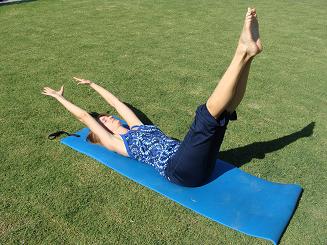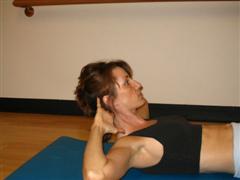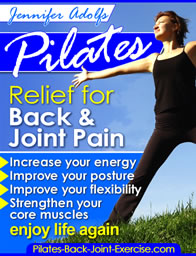Pilates Exercise: Mat, Water, and Weight Room
Pilates exercise is unique in that it systematically exercises all the muscle groups in the body, the weak as well as the strong.
It combines the suppleness and flexibility you find in yoga, the strength building you find in weight training in the gym, and the fluidity and gentleness on the joints you find in the water.
Read on to find out more about each of these areas.
PILATES MAT EXERCISE:
PROS
Pilates mat exercises can be performed anywhere at any time all you have to do is get down on the floor, hopefully one that is well cushioned if you have sore bones like me!
Pilates mat exercises were developed so that they are easily accessible for anyone, anytime, and even at home.

Pilates mat classes are more cost friendly ($10-$15 class) compared to a private session on the equipment ($40-$100) where you need to have a trained instructor to assist you, which I highly recommend if you are able to.
Find a certified instructor or studio near you.
You can find an assortment of various names and levels of mat Pilates DVD's and practice at home by yourself if you wish.
The mat exercises are flowing and invigorating and with consistent practice you should see and feel changes in your body after only a few sessions.
CONS
I would have to say the biggest con about doing mat exercise in a class setting or on your own is that you do not have the individual attention of the instructor watching your every move and correcting your bad postures and habits.
This can inhibit your progress and even cause some injuries to develop if you continue doing the exercises incorrectly.
A great way for you to get started safely and develop good habits is to have a look at the new Pilates Ebook that shows pictures and detailed descriptions of Pilates exercise on the mat from beginner to advanced level progressions.
I designed this Ebook for all levels and progressions of exercisers taking into account certain bone and joint conditions as I wrote it.
It is a great investment and less than the cost of one half hour individual session. But you get so much more!
PILATES FOR STRENGTH TRAINING: COMBINING THE TWO FOR ADDED BENEFITS
It now seems that the regular fitness routines we have been doing for so many years are incomplete, we have made exercises very safe: people don't injure themselves at the gym, but at home or at work.
What people don't realize is that the exercises they are doing in the gym do not prepare their bodies for the functionality of daily living.

In the gym your body parts are trained separately on individual machines or with dumbells.
Think of your body parts as a team that needs to practice working and training together to achieve balance and strength without injuries.
Some examples of the principles of Pilates exercise and how they can be incorporated into your Strength Training Routine:
The breathing in Pilates strength training exercise is the key to smooth rhythmic movements which helps the exercises flow together smoothly while repeating repetitions on a nautilus machine or with free weights.
The goal in breathing correctly helps to access intrinsic abdominal musculature from the inside out that creates a lifting sensation.
Your breath will help you to increase your awareness of length and strength in the body while stabilizing the core.
Lets apply this principle to the bench press. Lie supine with your eyes directly under the bar. Place your feet on the bench to maintain neutral spine, if necessary.
Retract or pull your scapula down to lift the bar off of its supports and lower it to nipple-line. Pause, taking a breath in.
As you exhale and extend the elbows feel your deeper abdominal muscles flatten out around your waist as you press your arms straight up over your chest. Notice how your pelvis and spine remain stable with the spine in a neutral position.
Imprinting is another fundamental Pilates exercise with a goal of finding the body's inherent ability to stabilize the trunk and spine using the core muscles.
Focus inward, bringing the awareness to the center or core of the body. Think about imprinting the core muscles around the spine for stability in a neutral position.
Apply this principle to the leg press seated.
Seated with your feet hip-width apart on the plate in front of you, hold the handles and contract the abdominals as you feel the core muscles stabilize around the spine to neutralize the trunk.
Keep the motion smooth and controlled as you exhale and press the plate away stabilizing the trunk and spine using the core muscles.

The Cervical Nod or Head Float is a fundamental Pilates Exercise that can be applied to almost all weight training exercises.
The goal is to create awareness of articulation at the 1st cervical vertebra while releasing tension in the suboccipital muscles.
The motion involves nodding the head like you are saying "yes" using a small range of motion, articulating at the first cervical vertebra or atlas.
All exercises that have a seat with the head extended high can be used to practice the cervical nod.
PILATES EXERCISE IN THE WATER:
The mind-body Pilates exercise have gone liquid. These mindful exercises have entered the world of water. Hidden just below the surface of the water you can experience the many benefits of Pilates and water.
Both exercise in the water, as well as Pilates exercises have a history of use as a treatment for musculoskelatal conditions.
Water exercises are low impact and have been used to treat chronic back pain, decrease pain, improve aerobic conditioning, increase strength, increase flexibility and initiate spinal stabilization efforts.
Pilates exercise has been around for a long time and also consists of low impact exercises.
Pilates exercises concentrate on building a strong body core with increased spinal range of motion, while strengthening abdominal and back muscles, they increase overall flexibility with the intention on correct posture.
Adding 12 times the resistance of air water heightens the strength-training elements of mind-body practices, while the buoyancy allows for less risk of injury.
The water enables larger range of motion and is an excellent place to stretch using Pilates core principles.
Water resistance is three-dimensional working your total body and allows decreased joint stress, so instead of going to the studio to perform “The Hundred” or any of your favorite Pilates exercises try it in the water and experience the flow and challenge of this form of Pilates.
Recent Articles
-
Pilates after Total Knee Replacement
Apr 23, 20 06:20 PM
It's 2 yrs.post op since I had total knee replacement in both knees. In order for them to last it's recommended that you lift not more than 25 lbs. Pilates -
SI Joint Pain Improved with Pilates!
Aug 11, 17 12:29 AM
Dear Jennifer, I just wanted to reach out and thank you for dramatically improving and changing my life. About a year ago, I woke up in debilitating -
Hip pain after 4 months of Reformer Pilates
Jul 12, 17 06:44 PM
Hi, I had a total right hip replacement 8 months ago; I rehabbed really quickly, although I was also (and still am) dealing with L4 spondylolisthesis.
 | Get Instant Access to Loads of Color Pictures, Postures, and Information Designed to Increase Comfort and Happiness. Learn to Enjoy Life Again! Learn More! |

New! Comments
Have your say about what you just read! Leave me a comment in the box below.